Related Research Articles

James Francis Edward Stuart, nicknamed the Old Pretender by Whigs, was the son of King James II and VII of England, Scotland and Ireland, and his second wife, Mary of Modena. He was Prince of Wales from July 1688 until, just months after his birth, his Catholic father was deposed and exiled in the Glorious Revolution of 1688. James II's Protestant elder daughter, Mary II, and her husband, William III, became co-monarchs and the Bill of Rights 1689 and Act of Settlement 1701 excluded Catholics from the English throne and, subsequently, the British throne.
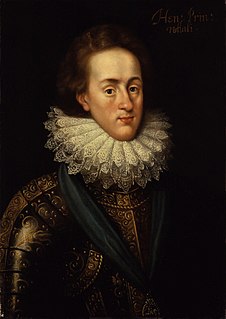
Henry Frederick, Prince of Wales, was the eldest son and heir apparent of James VI and I, King of England and Scotland; and his wife Anne of Denmark. His name derives from his grandfathers: Henry Stuart, Lord Darnley; and Frederick II of Denmark. Prince Henry was widely seen as a bright and promising heir to his father's thrones. However, at the age of 18, he predeceased his father when he died of typhoid fever. His younger brother Charles succeeded him as heir apparent to the English, Irish, and Scottish thrones.
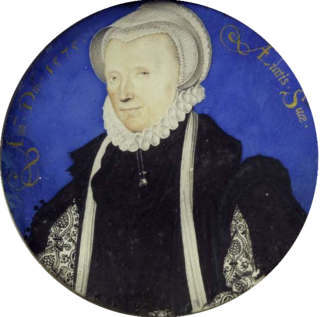
Margaret Douglas, Countess of Lennox, was the daughter of the Scottish queen dowager Margaret Tudor and her second husband Archibald Douglas, 6th Earl of Angus. In her youth she was high in the favour of her uncle, Henry VIII of England, but twice incurred the King's anger, first for her unauthorised engagement to Lord Thomas Howard, who died in the Tower of London in 1537 because of his misalliance with her, and again in 1540 for an affair with Thomas Howard's nephew Sir Charles Howard, the brother of Henry's wife Catherine Howard. On 6 July 1544, she married Matthew Stewart, 4th Earl of Lennox, one of Scotland's leading noblemen. Her son Henry Stuart, Lord Darnley, married Mary, Queen of Scots, and was the father of James VI and I.

St James's Palace is the most senior royal palace in the United Kingdom. It gives its name to the Court of St James's, which is the monarch's royal court and is located in the City of Westminster in London. Although no longer the principal residence of the monarch, it is the ceremonial meeting place of the Accession Council, the office of the Marshal of the Diplomatic Corps, and the London residence of several minor members of the royal family.

Thomas Wriothesley, 1st Earl of Southampton, KG was an English peer, secretary of state, Lord Chancellor and Lord High Admiral. A naturally skilled but unscrupulous and devious politician who changed with the times and personally tortured Anne Askew, Wriothesley served as a loyal instrument of King Henry VIII in the latter's break with the Catholic church. Richly rewarded with royal gains from the Dissolution of the Monasteries, he nevertheless prosecuted Calvinists and other dissident Protestants when political winds changed.
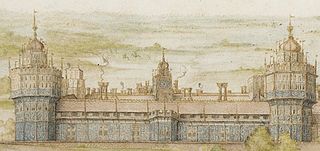
Nonsuch Palace was a Tudor royal palace, built by Henry VIII in Surrey, England; it stood from 1538 to 1682–83. Its site lies in what is now Nonsuch Park on the boundaries of the borough of Epsom and Ewell in Surrey and the London Borough of Sutton.

A farthingale is one of several structures used under Western European women's clothing in the 16th and 17th centuries to support the skirts in the desired shape and enlarge the lower half of the body. It originated in Spain in the fifteenth century. Farthingales served important social and cultural functions for women in Renaissance Europe as they were used, primarily by court women, to show their high social position and wealth.

The French hood is a type of woman's headgear that was popular in Western Europe in the 16th century.

Sir William Segar was a portrait painter and officer of arms to the court of Elizabeth I of England; he became Garter King of Arms under James I.
David Michael Loades was a British historian specialising in the Tudor era. He was Emeritus Professor of History at the University of Wales, where he taught from 1980 until 1996, and was Honorary Research Professor at the University of Sheffield from 1996 until 2008. In the 1960s and 1970s he taught at the universities of St. Andrews and Durham. From 1993 until 2004 he acted as Literary Director of the John Foxe Project at the British Academy; he subsequently became an Honorary Member of the History Faculty at the University of Oxford. After military service in the Royal Air Force 1953–1955, Loades studied at the University of Cambridge. He wrote many books on the Tudor period, including biographies. He was President of the Ecclesiastical History Society (1992–93).
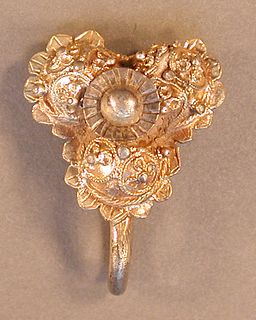
A dress hook is a decorative clothing accessory of the medieval and Tudor periods used to fasten outer garments or to drape up skirts. Made of base metal or precious silver and silver-gilt, dress hooks are documented in wills and inventories, and surviving hooks have been identified in the archaeological record throughout England.
Louis I d'Orléans, Duke of Longueville, was a French aristocrat and general, Grand Chamberlain of France and governor of Provence.
George W. Bernard is a British historian who specializes in the reign of King Henry VIII, specifically the English Reformation of the 1530s – both in England and globally – and the "reign" of Anne Boleyn. He is most famous for his arguments for the strength of Henry VIII as a ruler not controlled by faction, and for his theory that Anne Boleyn was guilty of adultery in 1536, based on a poem by Lancelot de Carles. He is commonly juxtaposed with David Starkey and Eric Ives, who have forcefully presented opposing arguments. Bernard's willingness to defend unpopular positions has been noted both by his admirers and his critics.

A partlet or partlett was a 16th century fashion accessory. The partlet was a sleeveless garment worn over the neck and shoulders, either worn over a dress or worn to fill in a low neckline.
George Kirke was a Scottish-born courtier and Member of Parliament for Clitheroe.

Alexander Miller or Millar (1559-1616) was an Edinburgh tailor who served James VI and I.
Cornelius van der Strete was a tapestry worker at the courts of Henry VII and Henry VIII of England.
Mary Finch or Fynche (1508-1557) was an English courtier of Mary I of England.

Cornelis Hayes or Heys was a Flemish jeweller who settled in London in 1524.
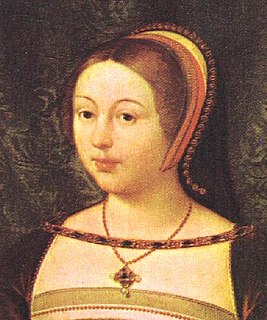
Several documents list the jewels of Margaret Tudor, daughter of Henry VII of England and Elizabeth of York. Margaret married James IV of Scotland in 1503.